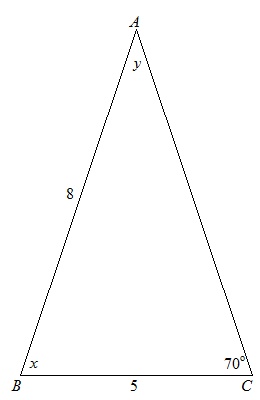

To see why there are no other lines of symmetry for these triangles, note that a line of symmetry must pass through a vertex of the triangle: if a line cuts the triangle into two polygons but does not pass through a vertex, then one of those polygons is a triangle and the other is a quadrilateral. Triangle facts, theorems, and laws It is not possible for a triangle to have more than one vertex with internal angle greater than or equal to 90°, or it would no longer be a triangle.

An equiangular triangle has three congruent angles. Finally, the triangle with side lengths 3,5,5 has one line of symmetry through the vertex where the two sides of length 5 meet. In an obtuse triangle, one of the angles of the triangle is greater than 90°, while in an acute triangle, all of the angles are less than 90°, as shown below. Note: It is possible for an obtuse triangle to also be scalene or isosceles. The triangle with side lengths 2,4,5 cannot have any lines of symmetry as the side lengths are all different. For the triangle all of whose sides have length 3, a proper fold through any vertex can serve as a line of symmetry and so there are three possible lines. For the triangle with side lengths 4,4,3 the only possibility is to fold so the two sides of length 4 align, so the line of symmetry goes through the vertex where those two sides meet. When the two sides meeting at a vertex do have the same length, the line of symmetry through that vertex passes through the midpoint of the opposite side. The two sides meeting at that vertex must be the same length in order for there to be a line of symmetry. The lines of symmetry for the four triangles are indicated in the pictureĪ line of symmetry for a triangle must go through one vertex. A word has been added at the end of the solution about why there are not other lines of symmetries for these triangles: this has been inserted in case this topic comes up in a class discussion but the focus should be on identifying the proper lines of symmetry. With a chance to experiment with physical models of triangles, gaining spatial
#Obtuse and isosceles triangle how to
This task is intended for instruction, providing the students In terms of the sides of the triangle, we will learn how to classify equilateral triangles which have all equal sides, isosceles triangles where two sides are equal, and scalene triangles where all. Helpful so that the students can fold them to find the lines. Forįinding the lines of symmetry, cut-out models of the four triangles would be Students an opportunity to recognize these distinguishing features of the different types of triangles before the technical language has been introduced. Lines of symmetry while an isosceles triangle has at least one line of symmetryĪnd an equilateral triangle has three lines of symmetry. The division of triangles into scalene, isosceles, and equilateral can be thought


 0 kommentar(er)
0 kommentar(er)
